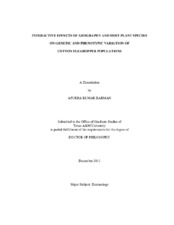| dc.description.abstract | The cotton fleahopper, Pseudatomoscelis seriatus (Reuter) is a widely distributed insect across the United States. Although, it feeds on several native wild hosts, its agricultural importance lies as an economic pest of cotton in several states in the southern United States. No studies have addressed intraspecific genetic and phenotypic variation of this insect pest at a large geographic scale.
I examined genetic variation among cotton fleahopper populations associated with cotton in different geographic locations across the southern United States (Chapter II). Using dominant, neutral, nuclear molecular markers (AFLP, amplified fragment length polymorphism) and mitochondrial DNA sequences, I found that overall genetic differentiation among different geographic populations, collected from cotton in eleven cotton growing states, was low but significant. AFLP revealed the presence of three regional groups representing western (Arizona), central (Texas, Oklahoma, Arkansas, Louisiana, Mississippi and Alabama), and eastern (Florida, Georgia, South Carolina and North Carolina) populations.
I examined if there were distinct lineages of cotton fleahoppers associated with three of its host plant species: cotton (Gossypium hirsutum), horsemint (Monarda punctata) and woolly croton (Croton capitatus) in five different locations of Texas by using AFLP markers (Chapter III). I found two distinct host-associated lineages at three locations and local panmixia in the other two locations.
I tested if host preference of cotton fleahoppers were affected by geographic variation and prior experience. Conducting choice tests with a Y-tube olfactometer, I found that host preference in cotton fleahoppers for horsemint (one of its native host plants) is conserved and unaffected by individual?s prior experience with cotton (Chapter IV).
Finally, I explored the role of host-plant species in morphological differentiation of the cotton fleahopper in two locations that differ in presence of distinct host-associated lineages. Using a geometric-morphometric approach, I detected significant effect of host plant and geography on body morphology and wing shape of cotton fleahopper populations (Chapter V). Length of antenna and rostrum were two important traits associated with morphological divergence of cotton and horsemint associated insect populations. Cotton associated individuals had relatively longer antenna and rostrum compared to individuals associated with horsemint. | en |


